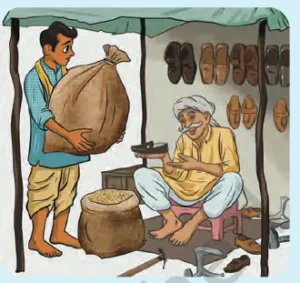
Practice Worksheet Chapter 11 From Barter to Money
Worksheet
Chapter 11-From Barter to Money
*************************************************
Section A: Multiple Choice Questions (10 × 1 = 10 marks)
- What was the main problem with the barter system?
a) Lack of products
b) Double coincidence of wants
c) Lack of communication
d) Too many buyers - What did the Aztecs use as a form of money?
a) Salt
b) Cattle
c) Copper Tajaderos
d) Silver coins - Which of the following is an example of digital money?
a) Cowrie shells
b) Paper notes
c) Debit cards
d) Gold coins - Which tribal fair in Assam still follows the barter system?
a) Hornbill Festival
b) Junbeel Mela
c) Surajkund Mela
d) Pushkar Fair - Which property of money allows it to be used in future transactions?
a) Divisibility
b) Portability
c) Store of value
d) Obsolescence
More:
6. Which metal was not commonly used in ancient Indian coinage?
a) Iron
b) Plastic
c) Gold
d) Copper
7. Who is responsible for printing currency notes in India today?
a) President of India
b) State Bank of India
c) Finance Ministry
d) Reserve Bank of India
8. The Chalukya coins carried the image of which deity?
a) Shiva
b) Vishnu’s Varaha avatar
c) Lakshmi
d) Ganesha
9. What is a common characteristic of alloy coins?
a) Cannot rust
b) Made of glass
c) Strong and durable
d) Transparent
10. What is the modern method of transaction using mobile phones?
a) Coinage
b) Net banking
c) QR Code payments
d) Credit slips
Section B: True or False (5 × 1 = 5 marks)
11. Coins in ancient India were issued by individual citizens. ❌ False
12. The barter system requires a double coincidence of wants. ✅ True
13. Paper currency was first introduced in India in the late 18th century. ✅ True
14. Durability means an object can break easily. ❌ False
15. Cowrie shells were used as money before coins. ✅ True
Section C: Fill in the Blanks (5 × 1 = 5 marks)
16. The ____________ system involved the direct exchange of goods without money.
Barter
17. A ____________ is a coin made by combining metals.
Alloy
18. The ____________ side of a coin is also called the head.
Obverse
19. One anna was equal to ____________ of a rupee.
1/16
20. The ₹ symbol was designed by ____________.
Udaya Kumar
To download Full Worksheet Click Below:
Chapter 11-From Barter to Money
Chapter 12- Understanding Markets
MCQs-
Chapter 11-From Barter to Money